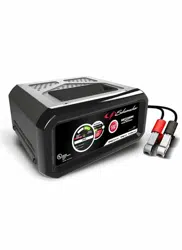Loading ...
Loading ...
Loading ...

• 6 •
caused by a drain on the battery or the
battery could be bad. Make sure there
are no loads on the battery. If there are,
remove them. If there are none, have the
battery checked or replaced.
MAINTAINING A BATTERY
The SC1283 charges and maintains 12V
batteries, keeping them at full charge.
NOTE: The maintain mode technology
allows you to safely charge and maintain
a healthy battery for extended periods
of time. However, problems with the
battery, electrical problems in the
vehicle, improper connections or other
unanticipated conditions could cause
excessive current draws. As such,
occasionally monitoring your battery and
the charging process is required.
COMPLETION OF CHARGE
Charge completion is indicated by the
CHARGED/MAINTAINING (green) LED.
When lit, the charger has switched to the
maintain mode of operation.
BATTERY CHARGING TIMES
APPLICATION
BATTERY
SIZE
CHARGING TIME (Hours)
2A 6A 8A 10A
POWERSPORTS
6Ah 6
32 Ah 15
AUTOMOTIVE
300 CCA 12
1000 CCA 30
MARINE
50 Ah 15
105Ah 33
2
5
4
10
5
11
1.75
4.5
3.5
8.5
4.25
9.5
1.5
4
3
7
3.5
8
Times are based on a 50% discharged
battery and may change, depending on age
and condition of battery.
ABORTED CHARGE
If charging cannot be completed normally,
charging will abort. When charging aborts,
the charger’s output is shut off and the
BAD BATTERY
(red) LED will be lit. Do
not continue attempting to charge this
battery. Have it checked or replaced.
DESULFATION MODE
Desulfation could take 8 to 10 hours.
If desulfation fails, charging will abort and
the BAD BATTERY
(red) LED will be lit.
USING THE ENGINE START SETTING
Your battery charger can be used to jump
start your car if the battery is low. Follow
all safety instructions and precautions for
charging your battery. Wear complete eye
protection and clothing protection.
WARNING: Using the ENGINE START
setting WITHOUT a battery installed in
the vehicle could cause damage to the
vehicle’s electrical system.
NOTE: If you have charged the battery
and it still will not start your car, do not
use the ENGINE START setting, or it
could damage the vehicle’s electrical
system. Have the battery checked.
1. With the charger unplugged from the
AC outlet, connect the charger to the
battery, following the instructions given
in Section 6 (Follow These Steps When
Battery is Installed in Vehicle).
2. Connect the charger to a live grounded
120V AC outlet.
3. With the charger plugged in and
connected to the battery of the vehicle,
press the RATE button until the 55A
ENGINE START option is selected.
The 55A ENGINE START (green) LED
will light.
4. Press the START/STOP button to
activate the Engine Start mode. If
a battery is properly connected, the
CHARGING/BOOST/ENGINE START
(yellow/orange) LED will light as well.
NOTE: Engine Start will not begin until
the STOP/START button is pressed.
5. Crank the engine until it starts, or 3
seconds pass. If the engine does not
start, wait 2 minutes before cranking
the engine again, to avoid overheating
the charger. NOTE: While in Engine
Start mode, every 3 minutes the unit
will enter into a COOL DOWN period
of 180 seconds, to allow both the
charger and the battery to cool down.
During this COOL DOWN period, the
CHARGING/BOOST/ENGINE START
(yellow/orange) LED will remain lit
and the 55A ENGINE START (green)
LED will blink, to indicate that ENGINE
START mode is in pause. When both
of these LEDs light solid again, you
may resume cranking the engine.
6. If the engine fails to start, use the 10A
BOOST rate for 5 more minutes before
attempting to crank the engine again.
NOTE: During extremely cold weather,
or if the battery is under 2 volts, use the
10A BOOST rate for 5 minutes before
cranking the engine.
7. After the engine starts, unplug the AC
power cord before disconnecting the
battery clamps from the vehicle.
NOTE: If the engine does turn over but
never starts, there is not a problem with
the starting system; there is a problem
somewhere else with the vehicle. STOP
cranking the engine until the other problem
has been diagnosed and corrected.
Loading ...
Loading ...
Loading ...
